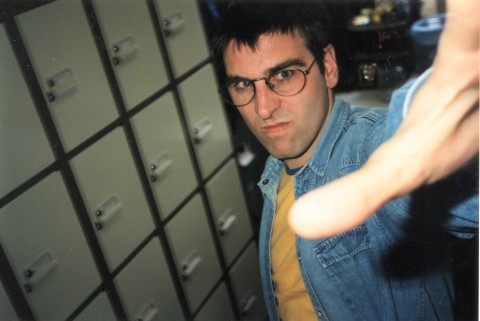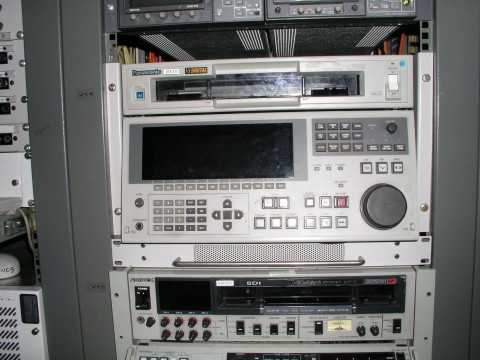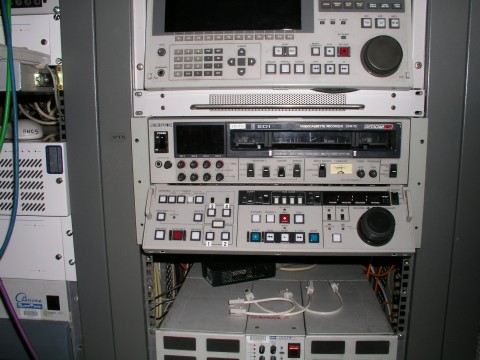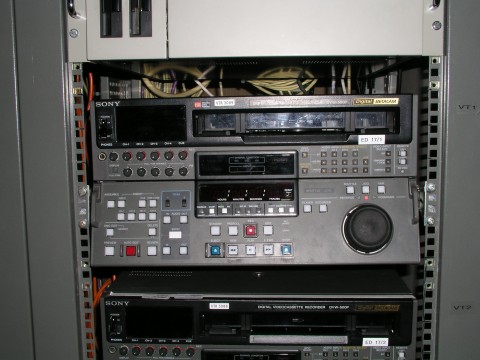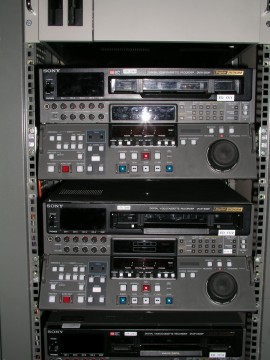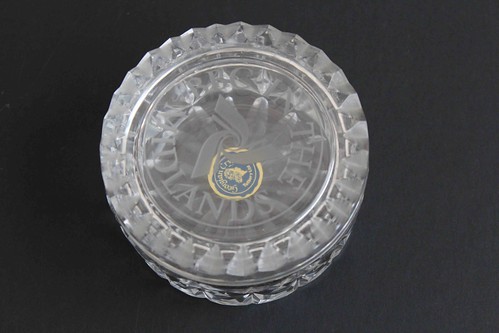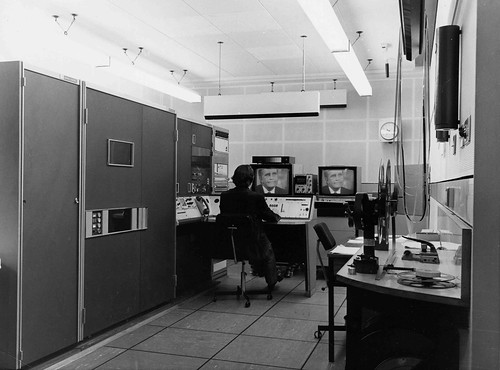Avid Editor James Hey, caught in mock anger by Kate Davis, no reproduction without permission!
Category: Building
Videotape machines in MFA
Photos by VT Editor, Ian Collins, no reproduction without permission.
Ian took photos of various pieces of kit, for posterity, before Pebble Mill was decommissioned in 2004.
These photos are of different videotape machines, including beta sp, and digibeta. Betacam sp, was a 1/2 inch analog videotape introduced as a format in the early 1980s and took over from U-matic tapes.
The machines were probably in MFA.
Mike Skipper added the following comment:
‘Just managed to have a closer look – the very top machine is indeed a Panasonic AJ-D350 1/2″ digital D3 recorder.
These machines saw heavy use at TV Centre until the 16:9 aspect ratio was settled upon as the standard recording format, at which point Digital Betacam became the preferred recording format. In very simplistic terms, D3 ‘digitised’ PAL signals before putting them to tape, whereas Digital Betacam processes signals in their component form.’
Pebble Mill building – photos by Tim Savage
Photos by Tim Savage, no reproduction without permission.
VT Editor, Tim Savage, took these photos of Pebble Mill in Autumn 2004, as the building was being de-commissioned.
In the photo of the entrance to the rear car park, someone seems to have helped themselves to a souvenir ‘C’ from the BBC logo!
The following comments were left on the Pebble Mill Facebook Group:
Gail Herbert: ‘It really is hard to realise that this building is no longer there – such happy memories.’
Brian Johnson: ‘London was always jealous of the success of P Mill so demolishing it under the guise of economy and using the ‘Mailbox’ made it look right on paper, but also made sure it was not a competitor to London productions (did I say London or Salford) ooops old age is a terrible thing, it seems to make you realise the truth.’
Pete Simpkin: ‘Still so fresh in the memory.’
Telecine – Ray Lee (Part 2)
Photo by Ivor Williams, no reproduction without permission. Photo from 1971, of the Rank Cintel 16mm Flying Spot Telecine Machine.
The majority of inserts to Midlands Today, and Pebble Mill at One were on film in those days (mid 1970s), as this was before lightweight cameras, and film cameras were at that time the best means to obtain location shots. Studio inserts were often recorded on VT then played in live quite often without editing. Film was much easier to edit then.
The process of getting a news story involved a film camera crew going out, shooting on film with sound onto tape. The tape also recorded a pilot tone from the camera to allow re-syncing of the sound after editing. The film (usually reversal film) then went into Film processing while the tape was transferred to Sepmag using the pilot signal to lock to the sepmag bay, thereby giving the sound track frame for frame correspondence with the film. The two parts then came back together in the film cutting room, where the film editor selected the parts he wanted using a Pic Sync ( basically a set of about 4 sprocket wheels on a shaft, with an illuminated mini projector on the far end to see the film images. The sepmag track (or tracks) would be on the nearer sprockets. On either side was a film bin. Often a “wild” track sound was recorded (not sync to pictures) in order to add additional effects and bridge edit points. The Clapper board was used to sync the sound and picture together with giving details of what item this was. The film editor would look for the first frame on which the clapper was completely closed, and align that with the clap on the soundtrack, thereafter the sprockets would ensure that the sound and picture remained in sync.
With news stories there was not usually time to go into dubbing, so the edited film and sound track then came straight to TK and one hoped that the edits on the sepmag would hold together.
Where time permitted a dub the sound was often tracklaid. This allowed sound to be carried over an edit to smooth the effect. In this case the sound was edited into 2 or more rolls with film spacer being used to make all the rolls the same length. Each roll would have a leader spliced onto it with the familiar sync cross and then a 12 second count down.
At the dub, the film projector and the sound rolls on the sepmag bays would all be locked together electrically so the they ran synchronously. The machines would be laced and set with the cross in the projector gate and on the sepmag sound head, and then the lock button pressed which linked everything together. Due to the nature of the electrical locking, very occasionally the sepmag bay would go into runaway, and one needed to hit the stop button fast, otherwise there was a danger that the film sprockets would be damaged, and a lot of film could end up very quickly on the floor!
Dubbing involved balancing and mixing the soundtracks together, adding any voice overs, commentary, and spot effects, and recording the whole sequence onto a new continuous sepmag track. At the end of the process there would be a single continuous sepmag track and a single edited picture track, which could then be played by TK into the studio.
The process was the same for network programmes on film, although in this case the film was usually shot on negative film, and a rushes print made. This is what the editor used to compile the required shots and soundtracks. The edited rushes were then returned to the lab for a print to be made from the original negative, using the rushes edit to align the required shots. The lab also graded the pictures at this stage to match the exposure and colour balance to some extent. This print was termed the “answer print”. This was usually the one used be dubbing, and sometimes also for transmission, although some programmes had a Transmission print made as well. The answer print basically gave an opportunity to the producer to change his mind, and for the lab to further trim the grading of pictures, although as it entailed quite a lot of expensive processes, in later years the answer print was quite often the transmission print as well.
By the time it got to TK there was usually a picture roll, and a sepmag sound roll. In a few cases (usually prints of commercial films) the sound was an optical track on the picture roll, in which case there was no separate sound. However this gave rise to problems if ever the film needed to be cut and spliced as the sound head was separated by 16 frames from the film gate so the picture would change, and the sound continue, only to change about half a second later.
In the case of news it was not uncommon for the editor to rush in with the film and sepmag rolls with very little time to get it on the machine before transmission. The one occasion I particularly remember involved me, and I think Jim Gregory, lacing the sepmag and picture rolls simultaneously, hitting the lock button and running the machine without even pausing on the “10” while Tom Coyne padded until the film hit the screen. Usually there was a little more time, and quite often we had a quick rehearsal, prior to the programme going out.
R. G. Lee
- « Previous Page
- 1
- …
- 89
- 90
- 91
- 92
- 93
- …
- 132
- Next Page »
